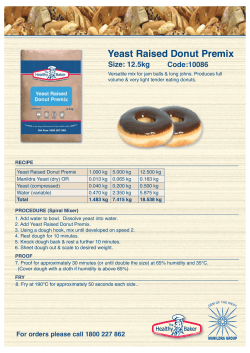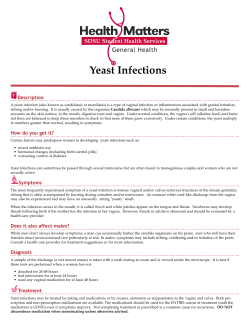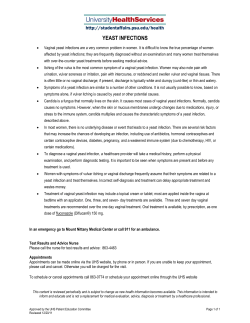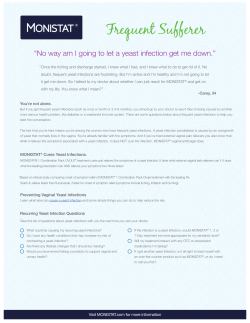
How Long Will I Be Blue - University of Missouri
Science in the Real World Microbes In Action Edited by: Teresa Thiel, Ph.D. University of Missouri-St. Louis Program Director & Microbiologist “How Long Will I Be Blue” is a curriculum unit developed as part of the Science In The Real World: Microbes In Action Program. The curriculum units were developed with support from the National Science Foundation, The Coordinating Board for Higher Education, Sigma Chemical Company, Pfizer Foundation and the Foundation for Microbiology. Don Cohn Developer of Curriculum Unit Teresa Thiel, Ph.D. Victoria L. May, M.A.T. University of Missouri-St. Louis Program Director & Microbiologist Science Education Resource Center Co-Director & Curriculum Specialist Mark R. Kalk, M.S. Sandra Alters, Ph.D. Brian Alters, Ph.D. Science Education Resource Center Lab Supervisor & Technical Specialist Program Evaluators Kimber Mallet Judith O’Brien, Ph.D. Illustrator Ralston Purina Industrial Consultant Bruce C. Hemming, Ph.D. Microbe Inotech Laboratory Industrial Consultant Alastair Pringle, Ph.D. Anheuser-Busch Industrial Consultant Robert Reynolds, Ph.D. Sigma Chemical Company Industrial Consultant David Corbin, Ph.D. Monsanto Industrial Consultant Copyright © 1999 by University of Missouri-St. Louis All rights reserved. No part of this publication may be reproduced, stored in a retrieval system, or transmitted, in any form or by any means, electronic, mechanical, photocopying, recording, or otherwise, without the prior written permission of the copyright owner (except as noted below*). *Teachers may copy only the student pages for educational use. 1 Table of Contents At A Glance ..................................................................................3 Student Pages How Long Will I Be Blue? .....................................................4 Data Sheet............................................................................6 Results and Analysis.............................................................7 Teacher Guide Overview...............................................................................9 Instructional Objectives.........................................................9 Background.........................................................................10 Sources of Supplies ............................................................10 Preparation .........................................................................11 Teacher Hints and Troubleshooting ...................................13 Results and Analysis Answer Key.......................................14 Letter to Parents ................................................................16 2 At A Glance Description This lab provides an easy, visual method for determining the rate of fermentation changes as a function of sugar concentration. The rate of fermentation is estimated using the time needed for the yeast to produce enough CO2 to acidify the medium. This change in acidity causes the pH indicator, bromthymol blue, to change from blue to green. Time Requirements This exercise requires a single 50-55 minute laboratory period. Curriculum Placement This exercise can be used in a general biology course during a unit devoted to cellular energetics (respiration), or it could be used as an introduction to scientific method and experimentation. Equipment test tubes test tube racks graduated cylinders or pipets droppers marking pens Students will need to be able to see a clock or use stop watches. Materials flask of yeast suspension 10 ml graduated cylinders flask of 2% sucrose solution 0.04% bromthymol blue solution 3 How Long Will I Be Blue? Yeast Fermentation of Sugar Background All cells require energy to maintain their complex structures and to grow and reproduce. Cells obtain the energy they need by breaking complex foods (organic molecules) into simpler molecules. Some cells completely degrade food molecules like sugars into CO2 H2O by a process called aerobic respiration. Some cells can only partially degrade sugars using a process called fermentation. Yeast are unicellular fungi that can perform aerobic respiration when oxygen is plentiful, but they can also obtain energy by the anaerobic process of fermentation when it is not. When yeast cells carry out fermentation, they convert sugar molecules into ethyl alcohol (C2H5OH) and CO2. Ethanol is another name for ethyl alcohol. The conditions used in this experiment provide only a small surface area exposed to air where oxygen is available to these cells. Because the volume of liquid below the surface quickly becomes anaerobic, fermentation is the predominant process that yeast will be using to obtain energy. As yeast carry out fermentation, the CO2 they release reacts with the surrounding water to produce carbonic acid. H2O + CO2—> H2CO3 Gradually the environment becomes more acidic. The change in acidity can be monitored by using an indicator dye like bromthymol blue, which changes color from blue to green to yellow as more and more acid is produced. By measuring the time required for the color to change from blue to green, you can observe how fast the yeast are releasing CO2. Yeast are of great economic importance. Their ability to carry out fermentation to produce ethyl alcohol is used in the production of alcoholic beverages such as beer and wine. In the production of bread, the carbon dioxide that yeast produce generates the gas bubbles that cause dough to rise. Most of the yeast found in the supermarket are sold in a dry, inactive form. When warm water is added to the yeast, they become active and will begin to grow and to carry out fermentation if they are given sugar as a food source. It takes about an hour for the yeast to become activated, so your teacher has prepared a suspension of yeast in water for you to use in this laboratory. You will “feed” these yeast different concentrations of sucrose (C12H22O11) to see how this affects the rate of fermentation. Given this information about yeast and fermentation, think about how the amount of sugar might affect the rate of fermentation and the rate of CO2 formation. Does more sugar cause more CO2 to form? Propose an “If …then…” hypothesis to answer this question. Record it in the Results section. 4 Materials per group 6 test tubes test tube rack marking pen 2% sucrose solution (with dropper) 2 -10 ml graduated cylinders yeast mixture (prepared immediately before class) Procedure 1. As a team of 6 students, obtain 6 test tubes and label them with the number of your solution (see data table). Your teacher will assign you the number of drops of sugar solution that you will be using. Enter this information on your Results and Analysis sheet (number 3). 2. To your test tube, add 5 ml of the yeast mixture that your teacher has prepared. Make sure to stir or swirl the flask of yeast vigorously before measuring out your 5 ml because the yeast tend to settle to the bottom of the flask. This mixture contains a small amount of activated yeast and some bromthymol blue indicator dye. A small amount of sodium hydroxide has been added to the mixture to make the starting color blue. 3. Before proceeding, make sure that you have access to a watch with a second hand, a clock, or a stopwatch. You will need to be able to see this throughout the experiment. 4. To your 5 ml of the yeast mixture, slowly and carefully add the exact number of drops of the sucrose solution you were assigned. Note: A drop is a fairly precise volume. It is the amount of liquid that naturally falls from the tip of the pipette as you apply gentle pressure to the bulb. There are about 24 drops in 1.0 ml. Do not squirt the sucrose solution into the tube. A squirt is much more than a drop. Take care not to introduce air bubbles into the pipette or you will have trouble getting an accurate drop to form at the tip of the pipette. 5. Finger vortex as directed by your teacher to mix the contents thoroughly. Immediately note the exact time in minutes and seconds and record this in your data table on the results and analysis sheet (number 4). Place the tube in your team’s test tube rack in the order listed in the table shown in figure 1. 6. After each one minute interval, finger vortex your tube and check for any color change in the solution. Compare the color of your tube to the color of solution tube 1. Once you detect a slight color change, check the color of your tube more frequently until the color is green. Record this as the ending time in question 4. Note: The color change will be gradual, and you will have to use your best judgment to determine when the blue has become green. The color will continue to change to a lighter green and eventually to a yellow color, but this is not a change that you need to record. 5 Name ___________________________ Date ____________________________ Data Sheet Gather your team’s data and record on the following data table. Pool class data and record the averages on the same table. Data table Test tube no. No. of drops Team Data Time (min) of 2% sucrose for color to change to green 1 0 2 2 3 4 4 6 5 8 6 10 Class Averages Time (min) for color to change to green Graph your team data and the class averages using different colors or symbols for each one. Include a legend to differentiate between the sets of data. Follow your teacher’s instructions when constructing the graph. 6 Name___________________________________ Date _________________________________ Results and Analysis 1. Explain your hypothesis. _______________________________________________________________ _______________________________________________________________ ______________________________________________________________. 2. Is there a control in this experiment? __________ Explain your answer._________ __________________________________________________________________ What is the purpose of a control? _______________________________________ __________________________________________________________________ 3. Record the sucrose concentration and number of drops that you have been assigned: Concentration of sucrose _______ Number of drops ______. 4. a. Starting time ____:_____(hr:min) b. Ending time ____:_____(time tube becomes green) 5. Subtract (a) from (b) to determine the number of minutes required for the color change to occur. Round off to the nearest half minute. Time for change to occur: _______ min. 6. Looking at your graph, is there evidence that the sucrose concentration affects the rate of fermentation in yeast? Explain your answer. __________________________________________________________________ __________________________________________________________________ 7 7. Using both team and class data, determine what sucrose concentration (number of drops of 2% sucrose in 5 ml of yeast) gave the highest rate of fermentation (remember that the highest rate of fermentation will give the shortest time for the color change). __________________________________________________________________ __________________________________________________________________ 8. In words, describe how varying the sucrose concentration affects the rate of fermentation in yeast. __________________________________________________________________ __________________________________________________________________ 9. Besides CO2, what other product is being produced by the yeast? __________________________________________________________________ 10. Devise an experiment that you could do to determine the temperature that results in the highest rate of yeast fermentation. Describe the experiment in as much detail as possible. Include materials and equipment. __________________________________________________________________ __________________________________________________________________ __________________________________________________________________ __________________________________________________________________ __________________________________________________________________ __________________________________________________________________ 8 Teacher Guide Overview This laboratory investigates and measures the metabolism of yeast using different concentrations of sugar. Students use a pH indicator to see that when sucrose is metabolized, a product of this reaction (CO2) lowers the pH of the solution. The result is a color change from blue to green to yellow. Students observe these changes and record the time it takes to complete one color change. The results are then graphed and compared. This lab may be used as either an introduction to the scientific method or as a fermentation lab. Instructional Objectives At the end of this unit the student should be able to: 1. demonstrate the methods of scientific inquiry by a. b. c. d. e. f. 2. demonstrate the following laboratory skills: a. b. c. d. e. 3. stating a problem writing a hypothesis performing an experiment according to given directions gathering and organizing data analyzing data developing further investigations using a graduated cylinder to measure volume using a dropper to measure volume mixing using the finger vortex method timing a chemical reaction graphing data demonstrate the understanding of the following scientific concepts: a. fermentation by: I. identifying the gas produced in the reaction II. explaining the color change seen in the reaction tubes III. identifying fermentation as a cellular process IV. describing the process of fermentation b. pH indicators by: I. identifying a color change as indicative of a pH change II. explaining how pH changes indicate chemical reactions 9 Background Energy utilization is a universal characteristic of living things. For most organisms, and most cells, the immediate source of energy used to synthesize ATP comes from breaking complex organic compounds, such as sugars, into simpler compounds. There are many pathways that can be used to degrade organic “food” molecules. The two most common methods are aerobic respiration and fermentation. Aerobic respiration is the process in which cells utilize oxygen (O2) to completely degrade sugars such as glucose (C6H12O6) into CO2 and H2O. Fermentation is an anaerobic process in which C6H12O6 is only partially degraded into smaller organic products such as lactic acid (C3H6O3) or ethanol (C2H5OH). During fermentation CO2 is produced. Yeast, a unicellular fungus, can obtain energy from sugars aerobically if O2 is plentiful, but under most growth conditions fermentation occurs, producing C2H5OH and CO2. In this laboratory exercise, the solutions are quickly depleted of their dissolved oxygen by the yeast. The solution becomes anaerobic everywhere but at the surface, where limited amounts of oxygen diffuse into the medium. When CO2 is dissolved in H2O, it produces carbonic -acid (H2CO3). This acid, in turn, can partially dissociate in water, producing H+ and HCO3 (bicarbonate). As more CO2 is produced, the medium becomes more acidic. This change in acidity can be detected by a pH indicator dye. The indicator used in this experiment, bromthymol blue, is blue above pH 7.6 and yellow below pH 6.0. In between these pH values, a continuum of colors from blue to green to yellow can be observed. By defining a particular color as the end-point of the experiment, the relative rates of fermentation in different samples can be determined if the samples began at the same pH. In this laboratory exercise the students will monitor the progress of fermentation indirectly by observing the color change of bromthymol blue resulting from the production of CO2 by yeast fermentation of sugar. Sources of Supplies Dry yeast was purchased at the supermarket. Do not use rapid rise yeast. Red Star works well and Fleishman’s regular yeast is fine. Sucrose (sugar) was purchased at the supermarket. Sigma Chemical Company P.O. Box 14508 St. Louis, MO 63178 Description bromthymol blue, sodium salt sodium hydroxide (pellets) Stock Number B8630 S0899 10 Quantity 1g 500g Cost $4.65 $20.00 Preparation The preparation for this laboratory depends on how you want your students to work. The experiment involves determining the relative rate of fermentation in 6 different concentrations of sucrose (the number of concentrations can be increased or decreased easily, but the range of concentrations recommended seems to work well). It is important that students work in teams so they can observe the sequential change in color of the six tubes. Depending on how many tubes you want to deal with and how many replicate tubes you want the class to generate, you could have each pair of students be responsible for one tube, or you could have each student do a single tube, or even have each student do more than one. The following directions are written for the case where each student is assigned one concentration of sucrose and is working in a team of six resulting in one complete experiment. Materials for Preparation Per group: Station(s) with the following: flask of yeast suspension described below (about 40 ml) 10 ml graduated cylinder(s) flask of 2% sucrose (20 ml) with dropper 6 test tubes (16-18 mm x 100-150 mm) test tube racks marking pens view of a clock, watch, or stopwatch Preparation of Stock Solutions a. Bromthymol blue, sodium salt (0.5%) Only a small volume of this concentrated indicator will be needed, but it is easiest to make a volume of 50 ml. Dissolve 0.25 g of bromthymol blue, sodium salt powder in 50 ml water. If the color is green or blue, you can use this solution. If it is yellow, titrate the solution drop-wise with 0.1% NaOH until it turns dark forest green or just turns blue. Do not add excess NaOH. b. 1.0% NaOH solution Dissolve 1.0 gram NaOH in 100 ml water. c. 0.1% NaOH solution Put 1 ml of the 1.0% NaOH solution into a test tube and dilute with 9 ml of distilled water. d. Sucrose solutions Dissolve 2g of sucrose in water and bring the total volume to 100 ml. Store the solution in the refrigerator. 11 Preparation on the Day of the Lab a. Yeast Suspension. 1 g of dry yeast (such as Red Star Yeast) is suspended in 10 ml of warm water (30-40º C). Mix thoroughly. Allow about 5 minutes for the yeast to become active. While it is activating, assemble the other reagents (see table below). This yeast suspension must be used within a few minutes to make the yeast mixture and the yeast mixture (see recipe below) must be used within about 30 minutes by the class. b. Yeast mixture (300 ml) - Make a fresh mixture for each class. Reagent Amount H2O................................................. 286 ml bromthymol blue indicator ................... 2 ml yeast suspension .............................. 10 ml 1% NaOH ............................................ 2 ml Mix thoroughly. The yeast mixture should be royal blue. If it is a green-blue, slowly add more 1% NaOH dropwise until the mixture is royal blue. This mixture should be used within about 30 minutes. As the yeast mixture sits, the yeast will metabolize glycogen stored in the cell and will release CO2, turning the dye green. If this happens, you should add more 1% NaOH to bring the color back to royal blue. Dispense the mixture into flasks to provide one flask for each group of students. Caution the students to swirl the suspension vigorously before they take samples. c. For each group, set up a station where students can measure out 5 ml of the yeast mixture using graduated cylinders (or pipets, if the students can use them). Also at the stations have labeled flasks of 2% sucrose with droppers. 12 Teacher Hints and Troubleshooting 1. The volumes of NaOH and yeast used are fairly critical. If too much NaOH is used, the yeast will not produce CO2 rapidly enough to bring about the indicator change within a class period. Too little NaOH will result in samples that change color much too rapidly. The ideal results will have the fastest sample changing from blue to green in about 5-10 min and the slower ones in 20-30 min. You may want to try the lab the day before the students do it. 2. You can test the yeast mixture to determine whether it will change color by removing 5 ml to a tube and blowing into the solution with a straw. The CO2 in your breath should cause the color to change from blue to green or yellow. If it does not turn within one minute you should remake the yeast mixture using less NaOH. 3. Before the lab (maybe a day before, if time looks like a problem) demonstrate to the class that bromthymol blue turns from blue to green to yellow as CO2 is added (by exhaling through a straw into a solution of bromthymol blue that has been made blue by the addition of a small amount of NaOH). 4. Yeast settle out of a suspension fairly quickly, so the flasks of the yeast suspension that the students use for this experiment must be swirled vigorously before each sample is removed. 5. Extensions of this activity could include examining the effect of temperature on the rate of yeast fermentation or determining the ability of yeast to ferment different sugars (glucose, fructose, lactose, etc.). One experiment that does not work is using different amounts of yeast. Yeast produce acid by metabolizing their glycogen reserves; therefore, more NaOH must be added if there are more yeast. 6. If successive classes are doing the experiment, make a fresh yeast-bromthymol blueNaOH mixture for each class. 7. The change in the indicator color is a continuous one. Students need to use their best judgment about when the blue color is gone and the suspension is really green. It helps to have them compare their tubes to their control tube, the tube with no sucrose added. You can provide a color standard (green) using construction paper. 8. Depending on the experiences of your students, you may have to go over the variables in this experiment and how they are graphed. The number of sucrose drops added is the independent variable and is placed on the x-axis. Time for the color to change in minutes is the dependent variable and is placed on the y-axis. 9. Finger vortexing is a simple way to mix solutions in a test tube. Hold the top of the tube securely in one hand and draw the index finger of the other hand toward you, gently hitting the tube. This creates a whirlpool effect inside the tube. 13 Results and Analysis Answer Key 1. Explain your hypothesis. The hypothesis should resemble this: The higher the concentration of the sucrose solution the faster the rate of fermentation and the change in color. 2. Is there a control in this experiment? Explain your answer. The control is the 0 drops of sucrose tube, tube 1. What is the purpose of a control? The purpose of a control is to serve as a reference. It is the setup in an experiment that does not contain the variable. In this experiment, the variable was the amount of sucrose. 3. Record the sucrose concentration and number of drops that you have been assigned: Concentration of sucrose _______ Number of drops ______ Answers will vary. 4. a. Starting time ____:_____ (hr:min) b. Ending time ____:_____ (time tube becomes green) 5. Answers will vary Subtract (a) from (b) to determine the number of minutes required for the color change to occur. Round off to the nearest half minute. Time for change to occur: _______ min. Answers will vary 6. Looking at your graph, is there evidence that the sucrose concentration affects the rate of fermentation in yeast? Explain your answer. Yes. The graph should show a sequential increase in time for the reaction to occur going from high to low concentrations. Actual student data may show some variations. 7. Using both team and class data, what sucrose concentration (number of drops of 6% sucrose in 5 ml of yeast) gave the highest rate of fermentation? (Remember that the highest rate of fermentation will give the shortest time for the color change.) Individual answers may vary but the class data should show the highest concentrations changing the fastest. 8. In words, describe how varying the sucrose concentration affects the rate of fermentation in yeast. The higher the concentration of the sucrose solution the faster the change in color which reflects the rate of fermentation. 14 9. Besides CO2, what other product is being produced by the yeast? ethyl alcohol 10. Devise an experiment that you could do to determine the temperature that results in the highest rate of yeast fermentation. Describe the experiment in as much detail as possible. Include materials and equipment. Answers will vary but should show scientific process. 15 Dear Parents: Science is the key to many industries. Two of the industries that come to mind as we think about this week’s activities are the brewing industry and the baking industry. In each of these industries, small organisms called yeast are at the very heart of the business. Yeast produce the gas bubbles that make bread light and airy. They also produce the alcohol and carbonation found in beer. Ask your child about the concepts learned during this unit. It might be a fun project for your family to try their hand at making homemade bread using yeast while we are watching yeast “do their thing” in the lab. As always, if you feel you have any expertise that could enhance the lesson, please feel free to contact me or make an appointment to come to school to visit us! 16
© Copyright 2025









